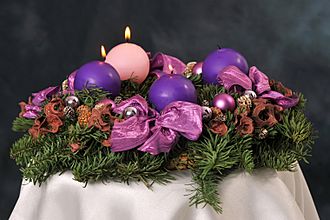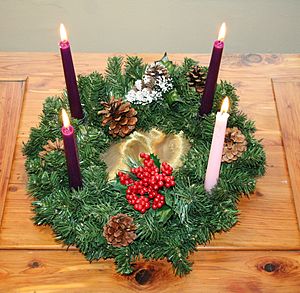Gaudete Sunday facts for kids
Quick facts for kids Gaudete Sunday |
|
|---|---|

One of the candles surrounding the Christ Candle in the Advent wreath is rose coloured for Gaudete Sunday, the beginning of the third week in Advent.
|
|
| Observed by | Western Christians |
| Type | Christian |
| Observances |
|
| Date | Second-final Sunday before Christmas Day |
Gaudete Sunday (pronounced gow-DET-eh) is a special day in the Christian calendar. It is the third Sunday of Advent, which is the time leading up to Christmas. Many Christian churches celebrate it, including the Roman Catholic Church, the Anglican Communion, and Lutheran Churches. This Sunday can happen between December 11th and December 17th.
Contents
What Does "Gaudete" Mean?

The name "Gaudete" comes from a Latin word that means "Rejoice!" or "Be joyful!" This word is the very first word of a special song, called an introit, sung during the church service on this day.
The song begins with these words: "Gaudete in Domino semper: iterum dico, gaudete." This means: "Rejoice in the Lord always; again I say, rejoice!" These words come from the Bible, specifically from the Book of Philippians (Chapter 4, verses 4-6). They remind everyone to be happy because Christmas and the coming of Jesus are very near.
Why is Gaudete Sunday Special?
Advent used to be a time of fasting, similar to Lent, which is a period of serious reflection before Easter. It was a time for preparing for Christmas. Over time, Advent became shorter, lasting four weeks.
Gaudete Sunday is like a happy break in the middle of Advent. It's similar to Laetare Sunday during Lent. It reminds people that even though Advent is a time of preparation, there's also great joy because Jesus is coming. The church services on this day focus on happiness and gladness, showing that the promised good news is very close.
What is the Theme of Gaudete Sunday?
Advent is about thinking of Jesus coming in three ways:
- His first coming as a baby at Christmas.
- His presence in our lives today.
- His future coming at the end of time.
On Gaudete Sunday, the main idea is to "rejoice in the Lord." It's about Christian joy. The readings often talk about John the Baptist, who prepared the way for Jesus.
Pope Francis, the leader of the Catholic Church, once said that Gaudete Sunday is about being thankful for all the good things in life. He encouraged people not to worry about what they haven't done for Christmas yet, but to focus on joy.
What Colors are Used on Gaudete Sunday?
During Advent, the usual color for church clothes and decorations is violet (a deep purple). But on Gaudete Sunday, churches can use rose-colored (pink) clothes and decorations instead. This is why it was sometimes called "Rose Sunday."
Many churches have an Advent wreath with candles. On Gaudete Sunday, the rose-colored candle is lit. Two other candles, usually violet or blue, are also lit. Even though Advent is a time for serious thought, the rose color and the readings on Gaudete Sunday highlight the joyful excitement for Jesus's arrival.
See also
 In Spanish: Gaudete para niños
In Spanish: Gaudete para niños
- Advent Sunday
- "Gaudete", a Christmas carol



